Stick skills v airmanship
FDR’s posts lead to another aspect of the flying in the opening video and a subject I’ve mentioned in a few PM’s but will repeat here.
Military or commercial, this aspect of qualification in the helicopter business is pretty much the same. During development, a flight loads survey is flown by the contractor. The maneuvers gross weights and altitudes are agreed upon either by the FAA or the respective military service. The flight loads data are then compared with the ground test fatigue load test data from the lab testing of components and then applied to the flight spectrum agreed to by the customer ( military ) or the FAA. Out of this the component replacement times ( CRT’s ) are derived and put in the maintenance manuals.
Now, we are talking about fatigue damage, not static overload failure. I have no idea of how the flight loads survey for that model Robinson was conducted nor whether the maneuvers in the video were included.
Here is an example-perhaps a bit far out, but true:
Before the main marketing effort with the S-67 Blackhawk took place, we had done the limited aerobatic maneuvers with full structural instrumentation. We had done rolls both to the left and right. Roll rates were similar-around 100 deg/sec. Rolls were done with pedals fixed ( as was the collective ). Rolls to the left, however, resulted in tail rotor bending moments that were high enough to affect the fatigue life of that component, Enough such that all the rolls on all of the marketing trips etc were done to the right.
So, when you see an aircraft being flown in what looks like an over-aggressive manner, the real question( or better: questions, plural ) to ask is whether the manufacturer had included that sort of flying in the flight loads survey and then whether some components have reduced CRT’s as a result. N.B. After seeing Karl Zimmermann perform his simply beautiful aerobatic ballet at the 1982 Hanover Airshow, I asked him abut that subject in general, and he told me that MBB had provided a structural clearance for his show ( I do not recall if there were CRT penalties ).
Military or commercial, this aspect of qualification in the helicopter business is pretty much the same. During development, a flight loads survey is flown by the contractor. The maneuvers gross weights and altitudes are agreed upon either by the FAA or the respective military service. The flight loads data are then compared with the ground test fatigue load test data from the lab testing of components and then applied to the flight spectrum agreed to by the customer ( military ) or the FAA. Out of this the component replacement times ( CRT’s ) are derived and put in the maintenance manuals.
Now, we are talking about fatigue damage, not static overload failure. I have no idea of how the flight loads survey for that model Robinson was conducted nor whether the maneuvers in the video were included.
Here is an example-perhaps a bit far out, but true:
Before the main marketing effort with the S-67 Blackhawk took place, we had done the limited aerobatic maneuvers with full structural instrumentation. We had done rolls both to the left and right. Roll rates were similar-around 100 deg/sec. Rolls were done with pedals fixed ( as was the collective ). Rolls to the left, however, resulted in tail rotor bending moments that were high enough to affect the fatigue life of that component, Enough such that all the rolls on all of the marketing trips etc were done to the right.
So, when you see an aircraft being flown in what looks like an over-aggressive manner, the real question( or better: questions, plural ) to ask is whether the manufacturer had included that sort of flying in the flight loads survey and then whether some components have reduced CRT’s as a result. N.B. After seeing Karl Zimmermann perform his simply beautiful aerobatic ballet at the 1982 Hanover Airshow, I asked him abut that subject in general, and he told me that MBB had provided a structural clearance for his show ( I do not recall if there were CRT penalties ).
That's what I thought, in general terms, anyway. Hence the example video of Dennis' air show routine not being anywhere near that far from the crowd. No matter how good you are, and he was great, and how much you practice, and how carefully you plan, you can still crash, and even he did once, famously. And the same is pretty much true of many air show performances. Don't forget the crowds want to be part of the show, too. Standing 500M away is not going to cut it for them. They have their own personal risk assessments. Many an air show spectator has been killed over the years.
Agreed.
Lot's of typing in this post, and your following post, but I did not see a single sentence about how you went 50+ KN sideways in an R22. Or did I miss that? So still waiting for the rest of that story, please.
Agreed.
Lot's of typing in this post, and your following post, but I did not see a single sentence about how you went 50+ KN sideways in an R22. Or did I miss that? So still waiting for the rest of that story, please.
PM me for details. The value I obtained was during development testing and involved 2 of 3 mods that were being examined, of which an STC was completed for one only. That permitted an exploration of loads above where the helicopter was normally limited. The minimum mod was run on 0015, 63015, 0012, 63215, VR-7, OA-209 and RC-04 sections to name a few, as far as helicopter blades go. It was run on up to the SK61, UH1H/T701, AS350, B206, H500, H300, R22, R44 EN280, and a whole lot of experimental types. The largest blade it was run on was 150' diameter, with modest tip speeds. The EN28 series has a stunningly low tip speed, around 550FPS, the R22 around 699, R44 is slightly lower, the B206 is around 735 or so, a long time since I bothered with the numbers, 2012, and the last test I ran was 2017. The EN28 had a weird outcome, which was good, it gave compelling evidence as to what was occurring, and that led to a distraction of doing the same on the B737 wing. Read P.B. Martin & M. McVeigh, of Boeing at that time, or Holger Mai, Guido Dietz Wolfgang Geißler, Kai Richter, Johannes Bosbach and Hugues Richard Klaus de Groot of DLR. and M.E. Calvert & T.C. Wong. They are good primers and will assist in understanding what your blade does and what we did. Have a good look at the Cd/AOA and Cl/Cd that was achieved with conventional devices. That conventional devices increased Cd by ~50% over baseline actually indicate why there was a mechanism to cure that.
FDR’s posts lead to another aspect of the flying in the opening video and a subject I’ve mentioned in a few PM’s but will repeat here.
Military or commercial, this aspect of qualification in the helicopter business is pretty much the same. During development, a flight loads survey is flown by the contractor. The maneuvers gross weights and altitudes are agreed upon either by the FAA or the respective military service. The flight loads data are then compared with the ground test fatigue load test data from the lab testing of components and then applied to the flight spectrum agreed to by the customer ( military ) or the FAA. Out of this the component replacement times ( CRT’s ) are derived and put in the maintenance manuals.
Now, we are talking about fatigue damage, not static overload failure. I have no idea of how the flight loads survey for that model Robinson was conducted nor whether the maneuvers in the video were included.
Here is an example-perhaps a bit far out, but true:
Before the main marketing effort with the S-67 Blackhawk took place, we had done the limited aerobatic maneuvers with full structural instrumentation. We had done rolls both to the left and right. Roll rates were similar-around 100 deg/sec. Rolls were done with pedals fixed ( as was the collective ). Rolls to the left, however, resulted in tail rotor bending moments that were high enough to affect the fatigue life of that component, Enough such that all the rolls on all of the marketing trips etc were done to the right.
So, when you see an aircraft being flown in what looks like an over-aggressive manner, the real question( or better: questions, plural ) to ask is whether the manufacturer had included that sort of flying in the flight loads survey and then whether some components have reduced CRT’s as a result. N.B. After seeing Karl Zimmermann perform his simply beautiful aerobatic ballet at the 1982 Hanover Airshow, I asked him abut that subject in general, and he told me that MBB had provided a structural clearance for his show ( I do not recall if there were CRT penalties ).
Military or commercial, this aspect of qualification in the helicopter business is pretty much the same. During development, a flight loads survey is flown by the contractor. The maneuvers gross weights and altitudes are agreed upon either by the FAA or the respective military service. The flight loads data are then compared with the ground test fatigue load test data from the lab testing of components and then applied to the flight spectrum agreed to by the customer ( military ) or the FAA. Out of this the component replacement times ( CRT’s ) are derived and put in the maintenance manuals.
Now, we are talking about fatigue damage, not static overload failure. I have no idea of how the flight loads survey for that model Robinson was conducted nor whether the maneuvers in the video were included.
Here is an example-perhaps a bit far out, but true:
Before the main marketing effort with the S-67 Blackhawk took place, we had done the limited aerobatic maneuvers with full structural instrumentation. We had done rolls both to the left and right. Roll rates were similar-around 100 deg/sec. Rolls were done with pedals fixed ( as was the collective ). Rolls to the left, however, resulted in tail rotor bending moments that were high enough to affect the fatigue life of that component, Enough such that all the rolls on all of the marketing trips etc were done to the right.
So, when you see an aircraft being flown in what looks like an over-aggressive manner, the real question( or better: questions, plural ) to ask is whether the manufacturer had included that sort of flying in the flight loads survey and then whether some components have reduced CRT’s as a result. N.B. After seeing Karl Zimmermann perform his simply beautiful aerobatic ballet at the 1982 Hanover Airshow, I asked him abut that subject in general, and he told me that MBB had provided a structural clearance for his show ( I do not recall if there were CRT penalties ).
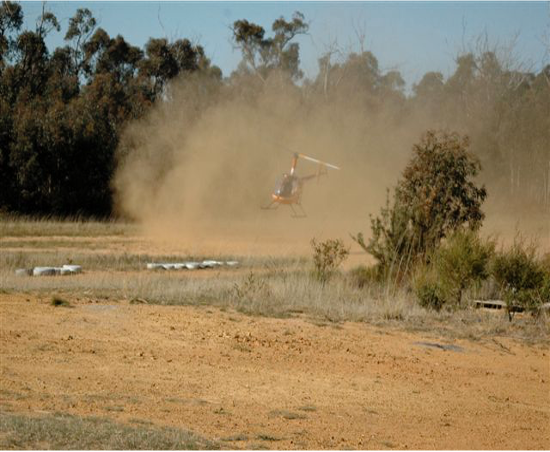
A quick and literally dirty flow visualization.
aa777888 - perhaps you now understand that an aircraft is tested far beyond the limits expected in normal use but its certification only guarantees sufficient yaw control up to 17 kts - anything you do above that figure and you become an unqualified test-pilot with no idea of the fatigue penalties you are inflicting on the various components.
Unlike civil aircraft, all (UK) military aircraft are operated under a release to service after test pilots have analysed the manufacturer's data and conducted their own tests to establish limits that ( with a suitable safety margin applied) a normal squadron pilot should be able to keep within and not cause a reduction in performance nor a significant fatigue-life reduction of components - thus establishing a maximum sideways and backwards speed envelope.
If you want to explore the problems associated with high sideways and rearwards speed then try incrementally approaching your certified 17 kt limit at a safe height noting pedal position and power as you gently accelerate, then go faster - once you get past 25-30 kts, let me know how comfortable you feel and how much power you think the guy in the video is using for his 'display'. You could also consider how, as fdr alludes to, you would fare in the event of an engine failure in those conditions.
Unlike civil aircraft, all (UK) military aircraft are operated under a release to service after test pilots have analysed the manufacturer's data and conducted their own tests to establish limits that ( with a suitable safety margin applied) a normal squadron pilot should be able to keep within and not cause a reduction in performance nor a significant fatigue-life reduction of components - thus establishing a maximum sideways and backwards speed envelope.
If you want to explore the problems associated with high sideways and rearwards speed then try incrementally approaching your certified 17 kt limit at a safe height noting pedal position and power as you gently accelerate, then go faster - once you get past 25-30 kts, let me know how comfortable you feel and how much power you think the guy in the video is using for his 'display'. You could also consider how, as fdr alludes to, you would fare in the event of an engine failure in those conditions.
BTW - there are no zero-risk airshow options other than not having them at all - do you worry about those debris-field issues when doing your 'pleasure' flights at big public events???
Join Date: Apr 2010
Location: USA
Posts: 850
Likes: 0
Received 0 Likes
on
0 Posts
Originally Posted by [email protected]
aa777888 - perhaps you now understand that an aircraft is tested far beyond the limits expected in normal use but its certification only guarantees sufficient yaw control up to 17 kts - anything you do above that figure and you become an unqualified test-pilot with no idea of the fatigue penalties you are inflicting on the various components.
BTW - there are no zero-risk airshow options other than not having them at all - do you worry about those debris-field issues when doing your 'pleasure' flights at big public events???
Originally Posted by [email protected]
aa777888 - perhaps you now understand that an aircraft is tested far beyond the limits expected in normal use but its certification only guarantees sufficient yaw control up to 17 kts - anything you do above that figure and you become an unqualified test-pilot with no idea of the fatigue penalties you are inflicting on the various components.
Unlike civil aircraft, all (UK) military aircraft are operated under a release to service after test pilots have analysed the manufacturer's data and conducted their own tests to establish limits that ( with a suitable safety margin applied) a normal squadron pilot should be able to keep within and not cause a reduction in performance nor a significant fatigue-life reduction of components - thus establishing a maximum sideways and backwards speed envelope.
If you want to explore the problems associated with high sideways and rearwards speed then try incrementally approaching your certified 17 kt limit at a safe height noting pedal position and power as you gently accelerate, then go faster - once you get past 25-30 kts, let me know how comfortable you feel and how much power you think the guy in the video is using for his 'display'. You could also consider how, as fdr alludes to, you would fare in the event of an engine failure in those conditions.
Unlike civil aircraft, all (UK) military aircraft are operated under a release to service after test pilots have analysed the manufacturer's data and conducted their own tests to establish limits that ( with a suitable safety margin applied) a normal squadron pilot should be able to keep within and not cause a reduction in performance nor a significant fatigue-life reduction of components - thus establishing a maximum sideways and backwards speed envelope.
If you want to explore the problems associated with high sideways and rearwards speed then try incrementally approaching your certified 17 kt limit at a safe height noting pedal position and power as you gently accelerate, then go faster - once you get past 25-30 kts, let me know how comfortable you feel and how much power you think the guy in the video is using for his 'display'. You could also consider how, as fdr alludes to, you would fare in the event of an engine failure in those conditions.
Well, I remember (if I recall correctly) them saying (when I was down at the Safety Course) that the 17 kts mentioned at the beginning of the Performance section of the POH (which has to do with hover controllability) was just what they were required to demonstrate during certification, and not a "limit" turning you into a test pilot were you to exceed it?
Anyway, if you are talking about a different 17 kts, then why is it not in the Limitations section of the POH?
Anyway, if you are talking about a different 17 kts, then why is it not in the Limitations section of the POH?
Well, I remember (if I recall correctly) them saying (when I was down at the Safety Course) that the 17 kts mentioned at the beginning of the Performance section of the POH (which has to do with hover controllability) was just what they were required to demonstrate during certification, and not a "limit" turning you into a test pilot were you to exceed it?
Anyway, if you are talking about a different 17 kts, then why is it not in the Limitations section of the POH?
Anyway, if you are talking about a different 17 kts, then why is it not in the Limitations section of the POH?
777888, Johndixson, tdracer,
This is a bit of history on a project on the VR7 blade which you would know is the CH/MH 47 blade, and nice it is too. The designers spend buckets of loot making a low Cm section, to keep pitch link loads in order, and then the darn pilot puts the 20 cents in the slot and cranks it up, spoiling all of that hard-earned effort.
None of the following look like the curves you would see in the FAA Helicopter Handbook, or the Airplane manual, all of the normal stuff is static pitch angles, these are the real world of rotors... where the pitching occurs at the shaft frequency. Conventional wisdom suggested at least for fixed-wing stuff that dynamic pitching was dependent on the change in pitch in the distance of a single chord, which definitely doesn't align with reality with choppers, The assumption is that the bound vortex has to have a limited time to develop, and that cannot be longer than the chord of the blade.... doesn't look like that in the real world. As a start or stop vortex rolls down the blade, it takes a finite time to do its bit of messing everything up, biggly. That may not be quite harmonic, in fact, I would be amazed if it was, this isn't a tidal locking sort of thingy; it is the convection of distortion down the blade, and it will run its course at its own rate, that is proportional to the blade velocity, but not exactly equal.
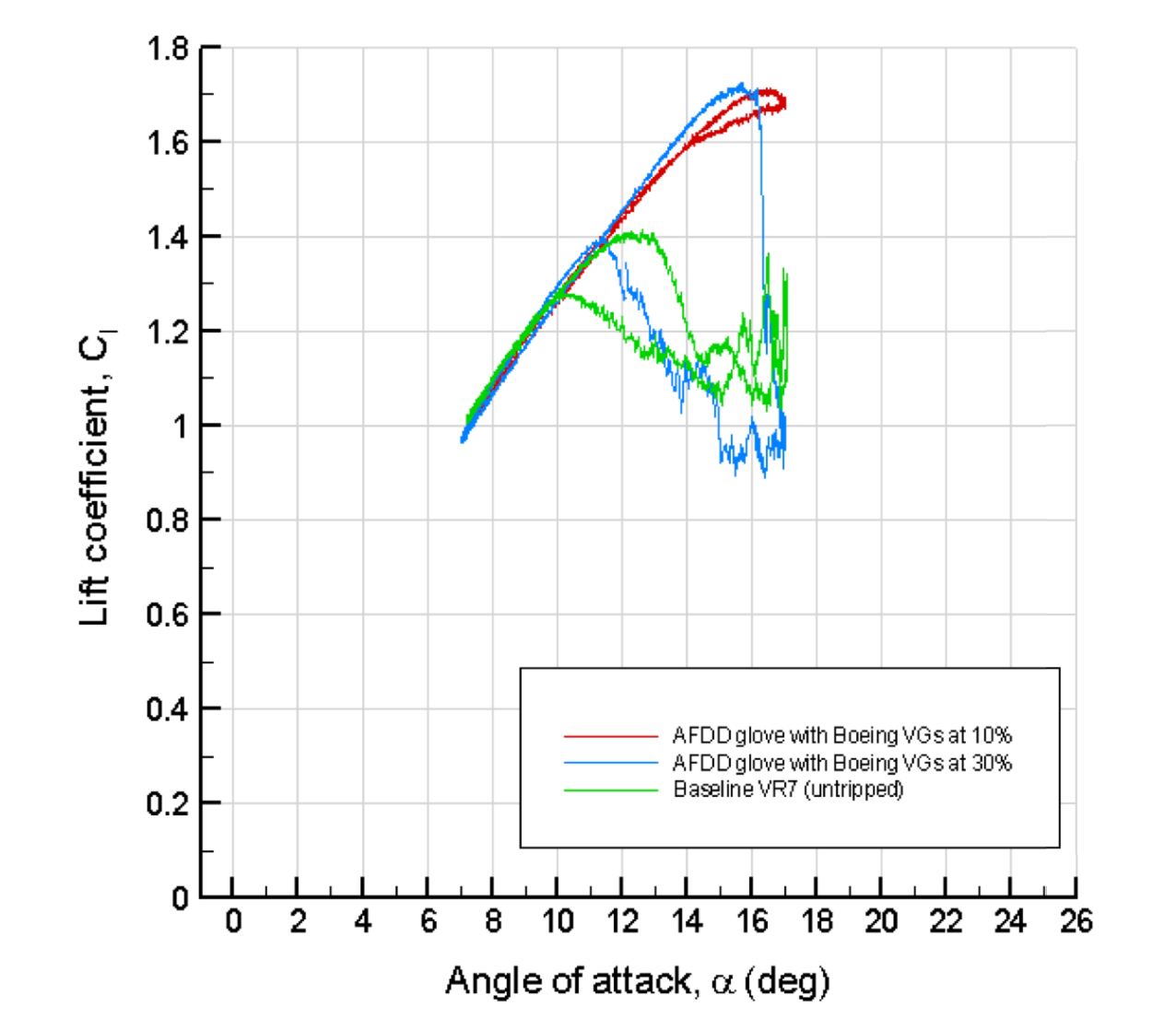
Take home: neat lines don't happen on helicopters. but stuff can be done about that.
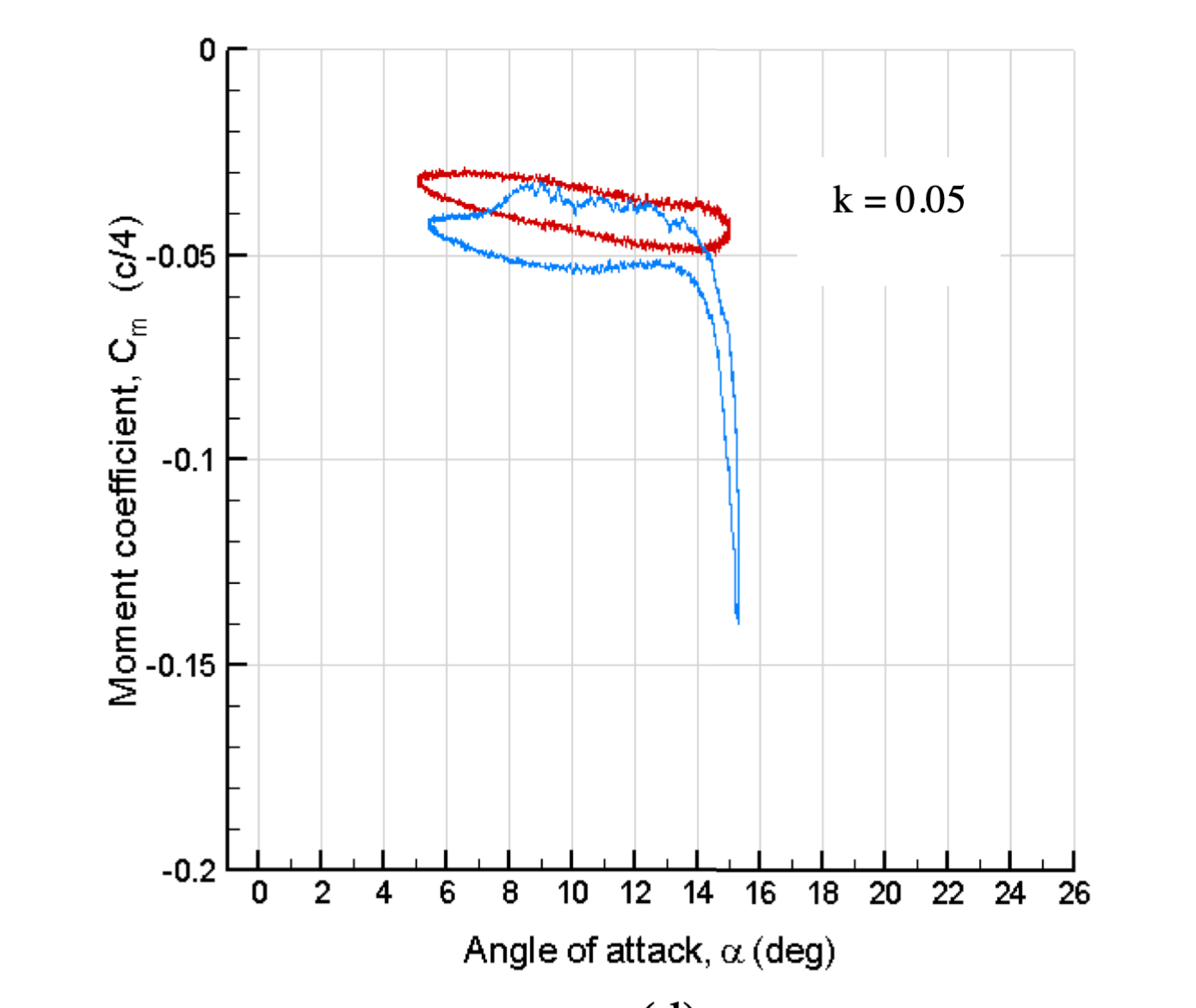
Take home: Oy! who ordered that. We spent good money on a low pitch moment section.... and you guys went and spun it up. Not fair!
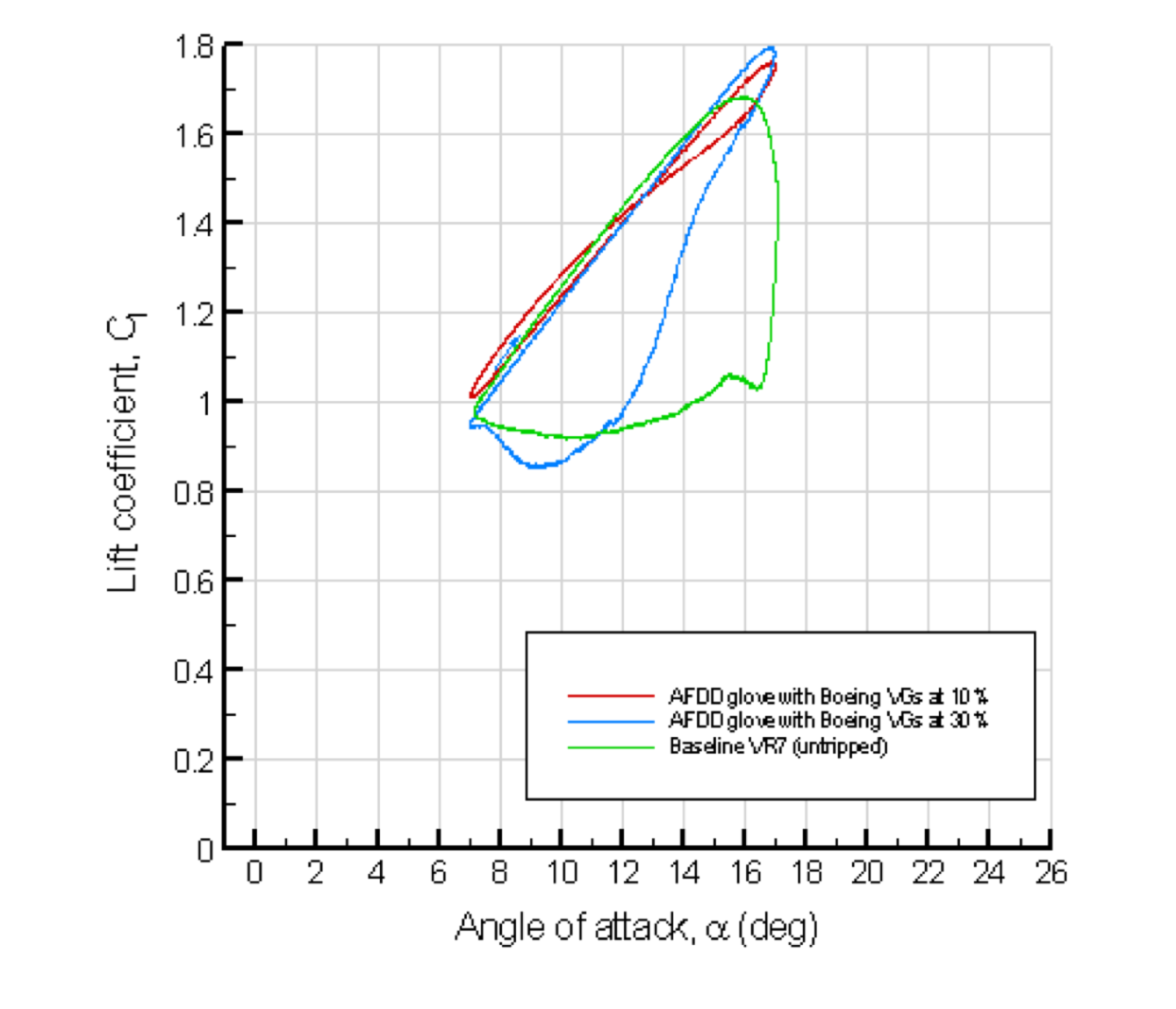
Take home: At least we can filter out some of the hairy wiggly bits....

Take home: Hey! wazzap here! we wanted better, not wusser.
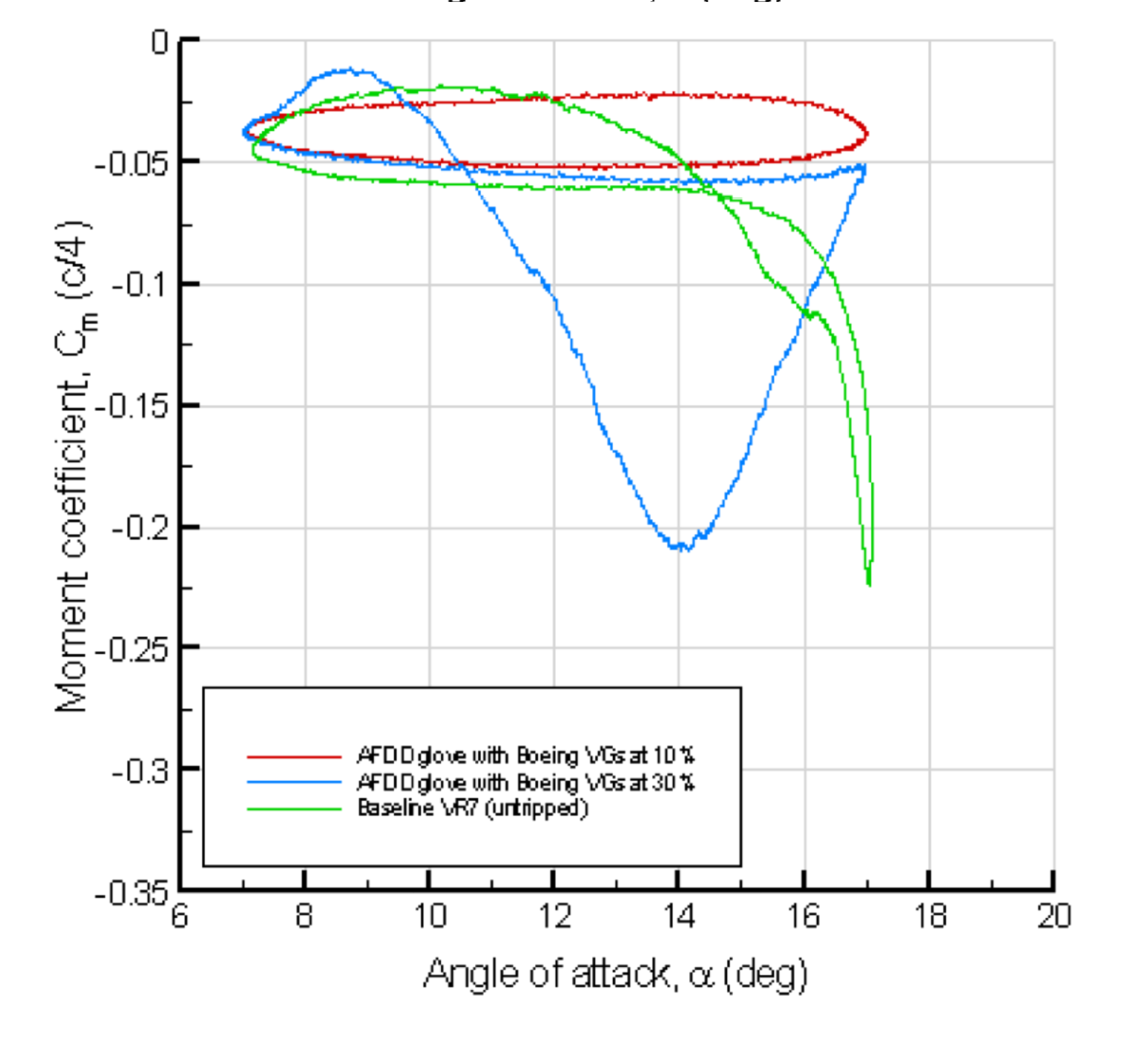
....
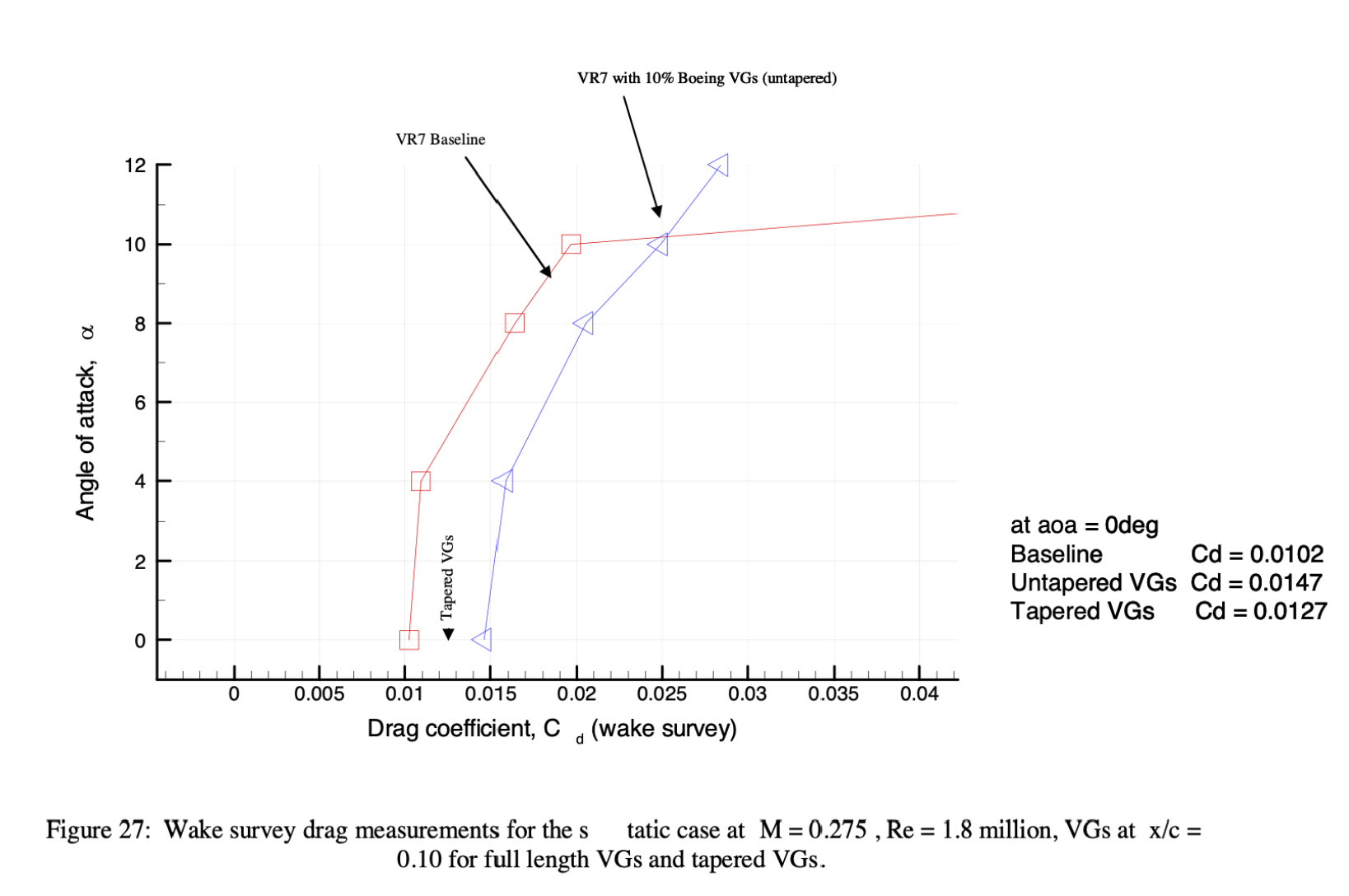
Take home: Ouch, we started with Cd of 0.01 and improved that to.... 0.015? a 50% increase in drag, but that doesn't happen on our non-flinging wings.. YGBSM!
For the drivers, that's what your loads are doing when you have a rotor in translation; the pitch is harmonically controlled, and that is the cause of the main vibes. does stuff about that is worth the effort, it keeps the fillings inside the dentine, and, all it needs is this device and 50% more torque, or something different, which is what we got. Boeing got a reduction in vibe and linearisation of the curves but had a 50% torque penalty due to the effect of radial acceleration on a free vortex in the wake of a VG. We got the vibe down, and torque requirement went down too, remove torque demand, apples for apples you reduce torque, increase anti-torque margin, and that adds to more control.
Martin, P., Wilson, J., Berry, J., & Wong, T. (2008). Passive Control of Compressible Dynamic Stall. 26th AIAA Applied Aerodynamics Conference, 1–33.
Last edited by fdr; 6th Feb 2021 at 06:11.
In CCW rotating helicopters ...
You make it appear so dramatic. If in right lateral flight you ran out of left rudder, the ship will straighten out (weathercock), and you continue in the same direction but now with the nose pointing in the direction of flight.
It is self-correcting and a non-event.
flight to the right increases the TR demand and the limit left pedal can be reached quite easily which gives a limit to how fast the lateral flight can be flown, disregarding risk etc. [...] total power required going to the right is increased by the TR up to reaching full pedal.
It is self-correcting and a non-event.
In CCW rotating helicopters ...
You make it appear so dramatic. If in right lateral flight you ran out of left rudder, the ship will straighten out (weathercock), and you continue in the same direction but now with the nose pointing in the direction of flight.
It is self-correcting and a non-event.
You make it appear so dramatic. If in right lateral flight you ran out of left rudder, the ship will straighten out (weathercock), and you continue in the same direction but now with the nose pointing in the direction of flight.
It is self-correcting and a non-event.
Originally Posted by [email protected]
Not sure how you can state that without being in the aircraft - you are assuming he is actually flying the manoeuvres skillfully. Sliding in and out of ETL with complex yaw and translation uses up more power than simple, basic manoeuvres.
Thank God I retired from flying helicopters before the internet had really got into gear. I would have hated to fly knowing what all those graphs and lines were doing to my machine.
Join Date: Apr 2010
Location: USA
Posts: 850
Likes: 0
Received 0 Likes
on
0 Posts
fdr
Please stop with the random data dumps and tell us about the day you flew the R22 sideways at 50+ KN. And about the tail rotor innovation that made that possible.
Because at this point I am being forced to believe that it never really happened.
Or just give us the old "it's all top secret, wink, nudge" line and be done with it.
Please stop with the random data dumps and tell us about the day you flew the R22 sideways at 50+ KN. And about the tail rotor innovation that made that possible.
Because at this point I am being forced to believe that it never really happened.
Or just give us the old "it's all top secret, wink, nudge" line and be done with it.
do you read your PMs?
I don't think aa777888 actually reads anything that he doesn't write.........a non-professional pilot demanding and reprimanding those that do it for a living........



